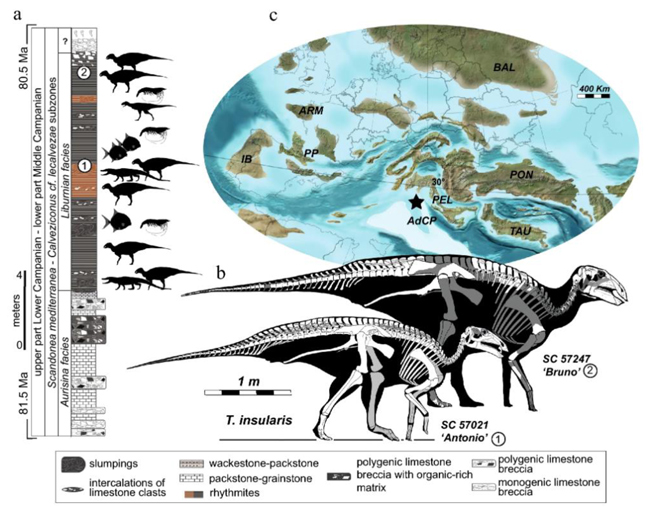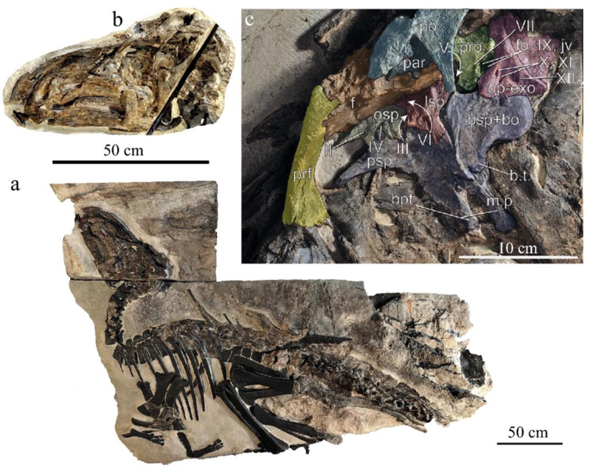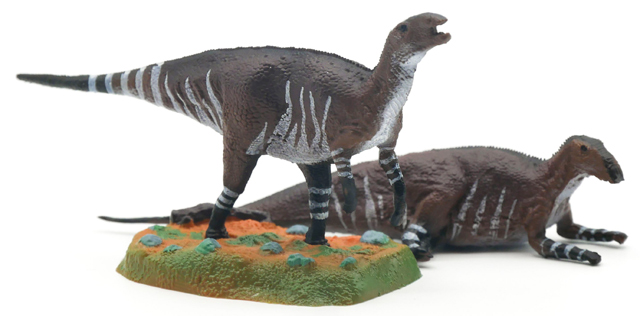Sizing Up Tethyshadros Thanks to New Research
Tethyshadros (T. insularis), which was formally named and described in 2009 from a superbly preserved fossil specimen discovered in a limestone quarry near to the village of Villaggio del Pescatore (Italy), had been thought to represent a dwarf hadrosaur. However, newly published research suggests that this Late Cretaceous dinosaur was not diminutive. Its body-size fits with the range in body sizes seen in other non-hadrosaurid Eurasian hadrosauroids.
The holotype specimen SC 57021 nicknamed “Antonio” represents a sub-adult. Writing in the academic journal “Scientific Reports”, researchers describe a second, much larger specimen SC 57247, which was discovered when “Antonio” was been excavated. The larger specimen given the moniker “Bruno” is much bigger and the original hypothesis that this taxon was a dwarf form is refuted in this new study.

Insular Dwarfism
During the Late Cretaceous much of Europe was covered by sea. There were numerous islands and these fragmented landmasses were populated by dinosaurs, many of which were dwarf forms when compared with closely related genera known from other continents. This was accepted as fossil evidence for the “island rule”, a theory, famously postulated by the 20th Century polymath Baron Franz Nopcsa von Felső-Szilvás. He proposed that the limited resources such as food, water and space on islands would result in a reduction of the size of animals that lived there. These island dwelling populations would become smaller over many generations when compared to their continental counterparts. Nopcsa referred to this idea as “insular dwarfism”.
The palaeo-Mediterranean region is best represented by the Villaggio del Pescatore quarry as it preserves a record of the fauna to be found on one of these islands. In this new research, this location is critically re-evaluated as early Campanian in age. This is significant, as it means that Tethyshadros lived prior to the final fragmentation stages of the European Archipelago. Tethyshadros lived prior to the emergence of the dwarf European taxa such as those animals associated with Hațeg Island which is geologically younger (Maastrichtian faunal stage of the Late Cretaceous).

Examination of the bones of “Bruno” (histological study), confirms that these dinosaurs were bigger than previously thought. The research team, which included Alfio Alessandro Chiarenza (Universidade de Vigo, Spain) and Matteo Fabbri (Field Museum of Natural History, Chicago, USA), conducted a phylogenetic analysis examining the body size of Tethyshadros compared to related species. They discovered that the body size of T. insularis is within the range of the body sizes of other non-hadrosaurid Eurasian hadrosauroids
Tethyshadros was not a diminutive form, it was not a “pygmy” dinosaur. Team members at Everything Dinosaur have updated their Tethyshadros fact sheet which is supplied with sales of Tethyshadros figures.
Although “Antonio” and “Bruno” perhaps represent the most complete and best preserved of all the European dinosaur fossils discovered to date, Tethyshadros does not feature in many model ranges. However, a pair of Tethyshadros figures was added to the Wild Past series last year (2021).
To view the Wild Past model range: Wild Past Prehistoric Animal Models.

The scientific paper: “An Italian dinosaur Lagerstätte reveals the tempo and mode of hadrosauriform body size evolution” by Alfio Alessandro Chiarenza, Matteo Fabbri, Lorenzo Consorti, Marco Muscioni, David C. Evans, Juan L. Cantalapiedra and Federico Fanti published in Scientific Reports.

